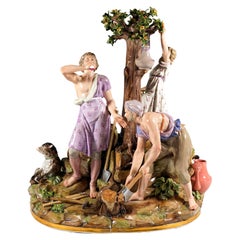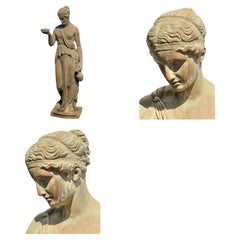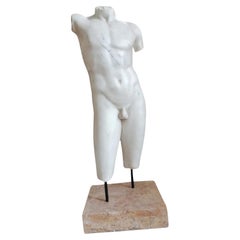Late 19th Century Figurative Sculptures
30
to
20
20
10
30
30
30
116
93
87
30
21
14
13
11
11
4
3
3
2
1
202
105
59
3
26
9
7
2
1
1
2
3
1
Height
to
Width
to
11
11
7
5
5
28
18
5
4
2
15
2
1
1
1
Style: Baroque
Period: Late 19th Century
Meissen Allegorical Group 'The Agriculture', by M.V. Acier, Germany, Ca 1870
Located in Vienna, AT
Excellent Meissen porcelain group of the 19th century.
Very large depiction of the allegory of agriculture grouped around an apple tree:
in the foreground an elderly man chopping wood...
Category
German Baroque Antique Late 19th Century Figurative Sculptures
Materials
Porcelain
19th Century French Plaster Statue of George Washington, Antique French Decor
Located in West Palm Beach, FL
This antique statue of the first President of the United States, George Washington, is made of French plaster and is in good condition, ...
Category
French Baroque Antique Late 19th Century Figurative Sculptures
Materials
Plaster
Pair of Italian Capitals in White Carrara Marble Final 19th / Early 20th Century
Located in Madrid, ES
Pair of Italian Capitals in white Carrara marble.
Final 19th / Early 20th century.
Measure: H: 39cm.
Some defects in the lateral ones.
some flaws in the marble
Category
Italian Baroque Antique Late 19th Century Figurative Sculptures
Materials
Carrara Marble
AMAZING "HEBE OF THORVALDSEN" POTTERY STATUE late 19th / early 20th Century
Located in Madrid, ES
HEBE OF THORVALDSEN POTTERY STATUE
late 19th / early 20th Century
HEIGHT 150cm
WIDTH 55cm
DEPTH 55cm
WEIGHT 50Kg
MANUFACTURE Tuscany - Italy
MATERIAL Terracotta
NOTE: ONLY DELIVERY...
Category
Italian Baroque Antique Late 19th Century Figurative Sculptures
Materials
Terracotta
Magnificent "Dorso Masculino" Sculpture in Carrara Marble the, Late 19th Century
Located in Madrid, ES
Magnificent "Dorso Masculino" sculpture in Carrara marble from the late 19th century.
Italy
Measures: H. 108cm x 37cm
Perfect conditions.
Category
Italian Baroque Antique Late 19th Century Figurative Sculptures
Materials
Carrara Marble
Pair of Bronze Putti With Rock Crystal Spheres
Located in Cypress, CA
Impressive 19 century pair of bronze babies with rock crystal spheres..
Can be placed everywhere and make a big statement.
Category
French Baroque Antique Late 19th Century Figurative Sculptures
Materials
Rock Crystal, Bronze
ROUND BAS-RELIEF OF PERSEPOLI PERSIA IN STONE late 19th Century
Located in Madrid, ES
ROUND BAS-RELIEF OF PERSEPOLI PERSIA IN STONE late 19th Century
This roundel is part of a series of roundels inspired by wonderful ancient Greek coins.
Freely reproduced from a Thr...
Category
Italian Baroque Antique Late 19th Century Figurative Sculptures
Materials
Limestone
ROUND STONE RELIEF OF HADRYAN Late 19th Century
Located in Madrid, ES
ROUND STONE RELIEF OF HADRYAN Late 19th Century
This roundel is part of a series of roundels inspired by the wonderful classical ancient Greek and Roman coins.
Freely reproduced from a gold coin (gold) of the emperor Hadrian. Roman, A.D. 134-38.
Bibliothèque nationale de France, Dép. des Monnaiies, Musee et Antique...
Category
Italian Baroque Antique Late 19th Century Figurative Sculptures
Materials
Limestone
Round of "Neron" in Terracotta Late 19th Century
Located in Madrid, ES
Round of "Neron"
In terracotta late 19th century
Diameter 55cm
Thickness 6cm
Weight 9kg
Material terracotta
Good condition.
Category
Italian Baroque Antique Late 19th Century Figurative Sculptures
Materials
Terracotta
Italian Ancient Fountain Fountain, Cementitious Malta End 19th Century
Located in Madrid, ES
ANCIENT FOUNTAIN FOUNTAIN - CEMENTITIOUS MALTA end 19th Century
Italy
external dimensions: cm.L110xL75x135H
internal basin cm.L95xL50x23H
HEI...
Category
Italian Baroque Antique Late 19th Century Figurative Sculptures
Materials
Cement
Stone Round of Lysimachus, Statere, Late 19th Century
Located in Madrid, ES
Stone Round of Lysimachus - Statere, late 19th century.
Italy
This roundel is part of a series of roundels inspired by wonderful ancient Greek coins.
Freely reproduced from a Thra...
Category
Italian Baroque Antique Late 19th Century Figurative Sculptures
Materials
Limestone
Italian Square Column in Terracotta End 19th Century
Located in Madrid, ES
Column support for statues and vases Ricceri.
Square column in terracotta end 19th century.
To be used as a support for vases, busts, sculptures etc.
From a cast of the ancient ...
Category
Italian Baroque Antique Late 19th Century Figurative Sculptures
Materials
Terracotta
Round Stone Relief with Portrait of Julian the Apostate Late 19th Century
Located in Madrid, ES
Round stone relief with portrait of Julian the apostate late 19th century.
Italy
This roundel is part of a series of roundels inspired by the wonderful classical ancient Greek...
Category
Italian Baroque Antique Late 19th Century Figurative Sculptures
Materials
Limestone
Bas-Relief in Marble Apuan Statuary of Thinking Athena End 19th Century
Located in Madrid, ES
Bas-relief in marble
Apuan statuary of thinking Athena
End 19th century
Italy
Measures: height 51 cm
Width 30 cm
Thickness 3 cm - it can vary from 3 cm to 4 cm
Weight 9 kg
Ma...
Category
Italian Baroque Antique Late 19th Century Figurative Sculptures
Materials
Marble
Titus Roman Emperor, Terracotta Round End, 19th Century
Located in Madrid, ES
Titus Roman Emperor, terracotta round end 19th century.
Diameter 31cm.
thickness 6cm.
weigh 8kg.
Material terracotta.
Very good condition.
Titus Flavius Caesar Vespasian Augustus (in Latin: Titus Flavius Caesar Vespasianus Augustus; in the epigraphs: IMP•T•CAESAR•VESPASIANUS•AVG•PON•M•TR•POT[1]; Rome, 30 December 39 – Aquae Cutiliae, 13 September 81, better known simply as Titus, was a Roman emperor, belonging to the Flavian dynasty, and reigned for just over two years from 79 to 81, the year of his death.
Before ascending the throne, Titus was an able and esteemed general who distinguished himself for the repression of the rebellion in Judea in 70, during which the second temple in Jerusalem was destroyed. He was considered a good emperor by Tacitus and other contemporary historians; he is known for his program of public works in Rome and for his generosity in rescuing the population following two disastrous events: the eruption of Vesuvius in 79 and the fire in Rome in 80. Famous is the definition that the historian Suetonius gave of him:
"Amor ac deliciae generis humani. » « Love and delight of mankind. »
Titus' family, the gens Flavia, belonged to that Italian nobility which, in the first half of the first century, was gradually replacing the more ancient Roman aristocracy, weakened by the decades of civil wars fought in the first century BC. The Flavians, in fact, were not of noble origins, but they managed, within just three generations, to rise from humble origins to the honor of the imperial purple. Tito's paternal great-grandfather, Tito Flavio Petrone from Rieti, had fought as a centurion evocatus in the army of Gnaeus Pompey the Great during the civil war of 49-45 BC, fighting in the battle of Farsalo and fleeing after the defeat of the Pompeians; he was pardoned by Cesare and became tax collector...
Category
Italian Baroque Antique Late 19th Century Figurative Sculptures
Materials
Terracotta
Important Sculpture "Esquiline Venus" Terracotta Late 19th Century
Located in Madrid, ES
IMPORTANT SCULPTURE "ESQUILINE VENUS" Terracotta late 19th Century
1:1 terracotta reproduction of the famous Esquiline Venus.
Almost certainly th...
Category
Italian Baroque Antique Late 19th Century Figurative Sculptures
Materials
Terracotta
Holy Water of "San Clemente in Rome" End 19th Century
Located in Madrid, ES
The holy water of "San Clemente in Rome" end 19th century
Hand made faithful reproduction with or without the coat of arms of the base
made in 3 pieces.
Italy
Measures: height 150cm
diameter 80cm
width: 80 cm
The Basilica of Saint Clement Lateran is a complex of buildings in Rome, Italy centered around a Catholic church dedicated to Pope Clement I. The site is notable for being an archaeological record of early Rome's religious, political, and architectural history. from the Christian era to the Middle Ages.
The old church was transformed over the centuries from a private home that was the site of clandestine Christian worship in the first century to a grand public basilica in the sixth century, reflecting the growing legitimacy and power of the emerging Catholic church.
The house was originally owned by a Christian consul and martyr, Tito Flavio Clemente, who was one of the first Roman senators to convert to Christianity. He allowed his house to be used as a secret meeting place for his fellow Christians, which religion was then prohibited.
There is evidence of a pagan cult at the site. In the 2nd century members of a Mithraist cult built a small temple dedicated to Mithras in an insula, or apartment complex, on the site. This temple, used for initiation rituals, lasted until around the end of the 3rd century.
Excavations in the 1860s revealed the first forgotten basilica underlying the medieval one. In the late 4th or early 5th century, after Christianity had become the official religion of Rome, the small church was enlarged, acquiring the neighboring insula and other nearby buildings; the architects began to work on the complex of rooms and patios, building a central nave on the site of the previous church, and an apse on the previous mithraeum. The new church was dedicated to Pope Clement I, a first-century Christian convert and a contemporary of Titus Flavius Clement. Restorations were undertaken in the 9th century and around 1080-99.1
Apart from those in the Church of Santa Maria Antiqua, the most extensive collection of wall paintings from the early Middle Ages are those found in the lower basilica of San Clemente. Over the following centuries, San Clemente became a "beacon" for church artists and sculptors, benefiting from the generosity of the Byzantine Empire. Currently, it is one of the most richly decorated churches in Rome.
The last great event that occurred in the lower basilica was the election in 1099 of Cardinal Rainerius of San Clemente as Pope Paschal II.
The current basilica was rebuilt in a campaign by Cardinal Anastasius, c. 1099-h. 1120, after the original church was burned to the ground during the Norman sack...
Category
Italian Baroque Antique Late 19th Century Figurative Sculptures
Materials
Marble
Holy Water of "San Clemente in Rome" End 19th Century
Located in Madrid, ES
Holy water from Friuli - Italy early 20th century
Breccia partridge, copy of a seventeenth-century artefact
Height 105cm
Diameter 70cm
Width70cm
Depth 40cm
Perfect conditions.
Category
Italian Baroque Antique Late 19th Century Figurative Sculptures
Materials
Marble
Very Large Bronze "Abduction of a Sabine Woman" After Giambologna, 19th Cent
By Giambologna, Ferdinando de Luca
Located in Paris, FR
Very large bronze sculpture with brown patina, based on the group "The Rape of the Sabine Women" by John of Bologna (Giambologna). This pivoting composition shows three figures in motion: a man on the ground defeated with his shield turned upside down, a second one arched clutching a woman launched towards the sky trying to escape, all on a naturalistic base. The Sabine man, the Roman and the Sabine woman are all depicted naked. This staging plays on serpentine lines known as "figura serpentinata" and diagonals giving a beautiful variety of volumes and a multiplicity of angles of view. The bronze is signed F. De Luca...
Category
French Baroque Antique Late 19th Century Figurative Sculptures
Materials
Bronze
Antique Baroque Bronze Nude Female Figure & Goatman Sculpture
Located in Toledo, OH
Antique cast bronze Baroque style sculpture of a nude female figure astride goatman. 14.5" tall x 10" x 8" . Unsigned. Verdigris patina. Very nice condition. Dimensions: 8" depth x 1...
Category
Unknown Baroque Antique Late 19th Century Figurative Sculptures
Materials
Bronze
Italy Sicily Late 19th Century Set of 4 Kitchen Wooden Tiles with Rural Scenes
Located in Brescia, IT
This particular set of wooden tiles, was handmade with colorful rural scenes, to decorate the sides of the Sicilian carts used during popular folks.
Thes...
Category
Italian Baroque Antique Late 19th Century Figurative Sculptures
Materials
Wood
Charming Pair of Austrian 19th Century Polychromed Majolica Wall Sculptures
Located in Los Angeles, CA
A fine and charming pair of Austrian 19th century polychromed majolica hanging wall sculptures of an elderly couple peeking through a window, probably by Friedrich Goldscheider (Goldscheider'sche Porzellan-Manufactur und Majolica-Fabrik.) Each wall sculpture depicting an elderly man wearing glasses and a traditional cap with his arms extended forward as if it was reading a book or a newspaper. The other depicting an elderly lady, also peeking through a window, wearing a laced cap with a bow tie and shawl over her shoulders, her arms are also extended forward as if it was reading a book or a newspaper. The male figure stamped on the back "78 - II ." The lady figure stamped on the back "37 - 79." Vienna, circa 1890-1900.
Man's height: 16 1/2 inches (41.9 cm.)
Man's width: 13 3/4 inches (34.9 cm.)
Depth: 8 1/2 inches (21.6 cm.)
Lady's height: 15 1/2 inches (39.4 cm.)
Lady's width: 13 3/4 inches (34.9 cm.)
Lady's depth: 6 1/2 inches (16.5 cm.)
Goldscheider Manufactory and Majolica Factory (German: Goldscheider'sche Porzellan-Manufactur und Majolica-Fabrik, (now) Goldscheider Keramik) is an Austrian ceramic manufactory.
In 1885, Friedrich Goldscheider came from the small Bohemian city of Pilsen to Vienna and founded the Goldscheider Manufactory and Majolica Factory. It became one of the most influential ceramic manufactories of terracotta, faience and bronze objects in Austria with subsidiaries in Paris, Leipzig and Florence. For over half a century Goldscheider created masterpieces of historical revivalism, Art Nouveau (Jugendstil) and Art Deco. Famous artists such as Josef Lorenzl, Stefan Dakon, Ida Meisinger and the two perhaps best known Austrian ceramic artists Michael Powolny and Vally Wieselthier worked for Goldscheider. Several of the artists who worked for Goldscheider also worked for other Viennese studios, such as Augarten, Keramos or for the German brands Rosenthal and Meissen.
The Goldscheider family emigrated in 1938 to United Kingdom and USA. Walter Goldscheider startet a new factory in Trenton, New Jersey and returned to Vienna in 1950. Marcel Goldscheider went to Stoke-on-Trent and produced figurative ceramics for Myott and opened his own studio in the 1950s in Hanley. Both brothers died in the early 1960s.
More than 10,000 different models were created over a period of three generations. Since the very beginning many of these won first prizes and gold medals at innumerable world fairs, exhibitions and trade fairs. Goldscheider figures...
Category
Austrian Baroque Antique Late 19th Century Figurative Sculptures
Materials
Majolica
1800s Lead Garden Statue
Located in Peekskill, NY
This is a 20 inch statue of a child holding a flame. The sculpture mislead and surprisingly heavy for its size. The patina is beautiful.
Category
Unknown Baroque Antique Late 19th Century Figurative Sculptures
Materials
Lead
Italy Sicily Late 19th Century Set 7 Kitchen Wooden Tiles with Rural Scenes
Located in Brescia, IT
This particular set of wooden tiles, was handmade with colorful rural scenes, to decorate the sides of the Sicilian carts used during popular folks.
Thes...
Category
Italian Baroque Antique Late 19th Century Figurative Sculptures
Materials
Wood
19th Century French Carved Terracotta Putti Sculpture Signed P. De Leonardi
Located in Dallas, TX
This large, charming, antique clay cherub composition was sculpted in France, circa 1880. The sculpture depicts two angelic children playing with a goat; the cherubs are nicely carve...
Category
French Baroque Antique Late 19th Century Figurative Sculptures
Materials
Earthenware, Terracotta
Mrs Devil 'Hall Figurine Attributed to Francesco Toso, 1875-1890
Located in Madrid, ES
This is a mephistophelic figure in solid wood carved of "Mrs. Devil" in the form of a hall support. Italy 1875-1890.
Measure: Height 185 cm -
Good condition,
Mother of pearl eyes.
Category
Italian Baroque Antique Late 19th Century Figurative Sculptures
Materials
Wood
19th Century French Polychrome Terracotta Musketeer Beer Drinker Figurine
Located in Dallas, TX
Accessorize your wet bar or wine cellar with this antique musketeer terracotta figurine. Created in Northern France, circa 1890, the "Terre Cuite" figure depicts a joyful musketeer i...
Category
French Baroque Antique Late 19th Century Figurative Sculptures
Materials
Ceramic, Terracotta
Meissen Grouping of Apollo's Sun Chariot with Sun Putti for Catherine the Great
Located in New York, NY
A magnificent and quite large, Baroque style, Museum quality, antique Meissen Porcelain grouping of Apollo, the Sun God's, Sun Chariot with his Putti Servant, originally designed by Johann Joachim Kändler in 1772-1773 for Czarina Katharina, Better known as Catherine the great...
Category
German Baroque Antique Late 19th Century Figurative Sculptures
Materials
Porcelain
Emil Wünsche Hunting Sculpture of a Hound and Pheasant Prey
By Emil Wünsche 1
Located in Los Angeles, CA
Emil Wu¨nsche (German, 1864-1938) a large overlaid brass figure titled "JAGDHUND MIT FASAN" (A Hunting Hound-Dog with its Pheasant Prey). The beautifully executed model of a hound, d...
Category
German Baroque Antique Late 19th Century Figurative Sculptures
Materials
Brass
Porcelain Figure, Meissen, 19th Century
Located in Belmont, MA
Meissen porcelain figure of a faun with her child. The child is sitting on a small chair while his mother is offering him to drink from a horn. Beautiful figure with passion for deta...
Category
German Baroque Antique Late 19th Century Figurative Sculptures
Materials
Porcelain
Recently Viewed
View AllMore Ways To Browse
Bronze By Carrier Belleuse
Red Marble Plinth
Hair Wreath
Thai Dance
Butterfly Wing Art
Carved Mermaid
Brutalist Sculpture Figure
Thai Dancer
Arts And Crafts Copper Sculpture
Brutalist Figural Sculpture
Guardian Figure
Hand Moveable
Irish Figural
Winged Maiden
Carved Alabaster Figure
Antique Brushed Bronze
Antique Italian Figurines
Used Furniture Waterloo





